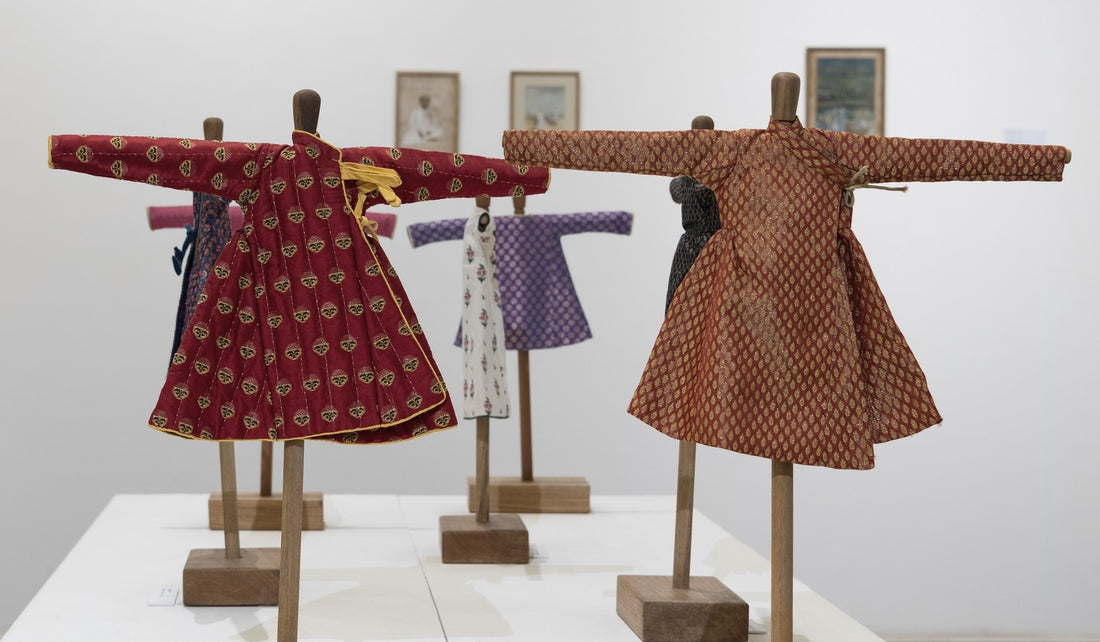
Small World

All images courtesy of Geeta Khandelwal.
Textile collector and researcher Geeta Khandelwal has created a unique collection of hand-stitched miniature classic costumes, depicting Indian dress from the 1850s to the 1950s. The miniature garments such as angarkhas, jamas, choghas, and sherwanis, were inspired by the book Indian Costumes by B.N. Goswami and Kalyan Krishanu, and were recently exhibited the Bhau Dadji Lad Museum, Mumbai.
The collection is a tribute to the ceremonial and everyday wear of the Maharajas of India and reflects the great diversity of fabrics available in the 19th century, from fine silks and brocades of Banaras, hand block prints of Rajasthan, fine muls and jamdanis of Bengal, woollen embroideries of Kashmir, and the ancient Chikankari from Lucknow. Sourcing the right fabrics has been one of the most difficult tasks, especially Kashmiri woven woollens. The velvet angarkha was also challenging, and it was not easy to find someone willing and capable to make the exquisite embroidery. With fabric sourcing not always easy, Khandelwal's own collection of vintage fabrics began to have a new life of their own.

Image: Sherwani.
The range of costumes made in miniature became a textile education for Khandelwal, ‘This has been an extraordinary journey for me, learning about cloth, textures, people and their cultures’. Many important garment types are presented. The chogha, a long-sleeved garment, is considered to be of Turkish origin. In the Indian context, the chogha was a more ceremonial garment, an outer garment that would be worn by noblemen at a court. The chogha is open from the neck downwards to the hemline below the knees. It is usually held together loosely by a pair of decorative cord loops and cloth encased buttons at the chest. Europeans used the chogha style as a dressing gown.

Image: Gaddi's coat.
Another key garment is the angarkha, whose name is derived from the Sanskrit word, ‘Angarakasaka’ which means, ‘that which protects or covers the body’. It is a loosely stitched upper garment for men, fitted on the bodice and flared at the skirt, has long sleeves. The lower part of the angarkha is kept open by adding gussets to the sleeves and gathering on the waist, to facilitate body movement.
Also represented in miniature is the sherwani. Now highly popular as wedding-wear, the sherwani is a long coat-like garment, often made from heavier suiting fabrics, very similar to a western frock coat. Originally associated with Muslim aristocracy during the period of British rule, it is worn over a kurta with the combination of either a churidar, adroit, a pajama or a shalwar as the lower-body clothing.
Guest post from Geeta Khandelwal.

4 comments
Absolutely beautiful!!
Absolutely beautiful. Lovely work.
Exquisite-I have known Geeta from my days in India when we exported her beautiful quilts to European customers….beautiful sensibility and what a way to preserve old formats of costumes.
Though I have lost touch with her 30 years ago after I moved to America -I still remember her persistence to details .Kudos to her.
thank you for sharing these beautiful pieces. I had missed your exhibit in Mumbai by a few days. would it be possible to purchase one of the pieces for my home? I hope you are safe. sharon